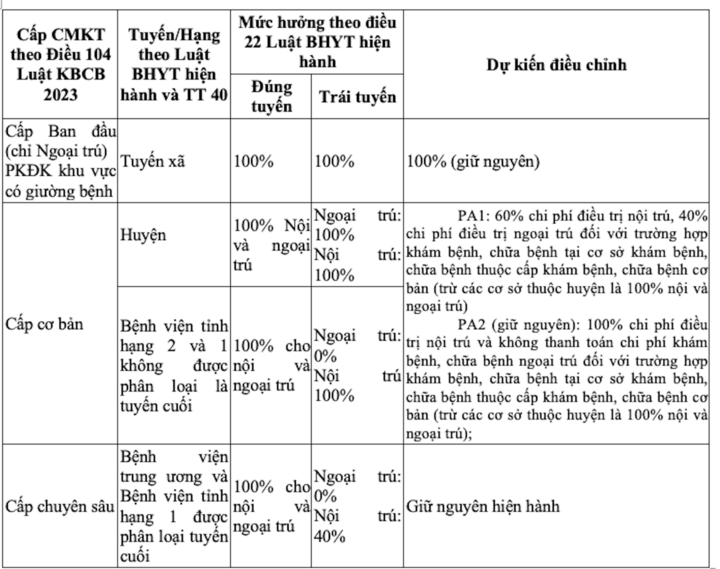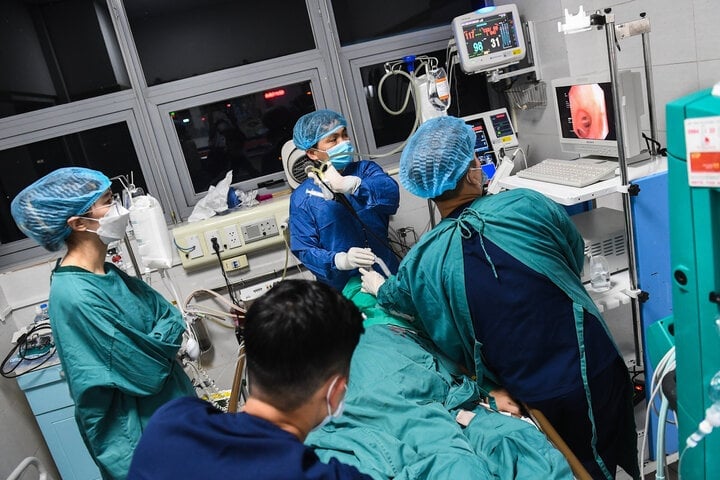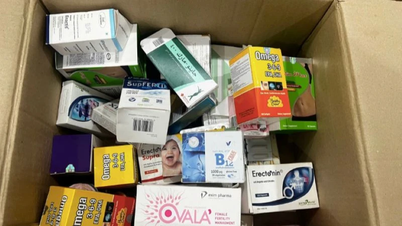This proposal was included by the Ministry of Health in the draft Law amending and supplementing a number of articles of the Law on Health Insurance, which is being consulted and will expire on March 20.
The Law on Medical Examination and Treatment (amended, effective from January 1, 2024) stipulates the conversion of 4 technical professional levels (commune, district, provincial, central) into 3 levels (initial, basic, specialized). Therefore, the Ministry of Health believes that it is necessary to amend and adjust the contents related to technical professional levels and hospital levels in the Law on Health Insurance to synchronize with the Law on Medical Examination and Treatment (amended), in order to ensure appropriate management of health insurance and payment of medical examination and treatment costs.
According to current regulations, the level of health insurance benefits when examining and treating patients outside the designated medical facility includes:
- At central hospitals and grade 1 provincial hospitals classified as final level (for example, Hanoi Obstetrics and Gynecology Hospital or Hanoi Oncology Hospital), patients with health insurance cards will have the Health Insurance Fund pay 40% of inpatient treatment costs (according to the benefit level stated on the card); no payment for outpatient examination and treatment.
- At grade 2 provincial hospitals and grade 1 provincial hospitals not classified as final care, the Health Insurance Fund pays 100% of inpatient treatment costs; does not pay for outpatient examination and treatment when not in the correct care line.
- At district hospitals, pay 100% of medical examination and treatment costs (both inpatient and outpatient) nationwide.
According to the proposed adjustment of the Ministry of Health in the draft Proposal for the Law amending and supplementing a number of articles of the Law on Health Insurance, patients who go to medical facilities for examination and treatment not in accordance with the regulations on procedures for health insurance examination and treatment will be paid 100% of the health insurance costs by the Health Insurance Fund for cases of medical examination and treatment at primary level facilities; regional polyclinics with hospital beds; district-level medical centers with hospital beds; district hospitals and a number of private facilities equivalent to district hospitals according to regulations of the Ministry of Health.

The level of health insurance benefits is adjusted and interpreted from the level and rank (as in the old Law on Medical Examination and Treatment) to the technical professional level (consistent with the revised Law on Medical Examination and Treatment). Source: Proposal for the Draft Law proposing the development of a Law amending and supplementing a number of articles of the Law on Health Insurance
The Ministry of Health also proposed a plan to reduce the payment rate of the Health Insurance Fund for inpatients and increase payment for outpatient treatment for cases of self-examination and treatment under Health Insurance (i.e. not at the right level) at specialized levels and some facilities at the basic care level.

Doctors at Bach Mai Hospital, a central medical facility (specialized level) focus on treating patients. (Photo: Thach Thao)
Specifically, for people who seek medical treatment outside the basic level (level 2 and level 1 provincial hospitals are not classified as final level), the Ministry of Health proposes two options:
Option 1: People with health insurance cards will have the Health Insurance Fund pay 60% of inpatient costs and 40% of outpatient costs (except for district facilities where 100% inpatient and outpatient costs are covered). This is a new option (currently 100% inpatient and 0% outpatient).
Option 2: Maintain current regulations, that is, 100% of inpatient treatment costs and no outpatient costs (except for district facilities, which are 100% inpatient and outpatient).
The Ministry of Health also pointed out that with the above proposed plan, the State may have to address public opinion regarding the reduction of benefits for patients who exceed the professional level of health insurance examination and treatment when reducing the payment rate. However, according to the drafting agency of the Ministry of Health, this content can be promoted so that people understand the benefits and agree.
The Minister of Health, when responding to voters' petitions before the 6th Session of the 15th National Assembly on the proposal to expand the health insurance coverage nationwide (including the central coverage), said that health insurance participants have been expanded to districts and provinces nationwide. The expansion of the coverage to central health facilities needs to be studied and considered to avoid overload. At the same time, it is necessary to increase health insurance coverage at the grassroots level and ensure the balance of the health insurance fund.
Source


![[Photo] Ready for the top competitions of Vietnamese table tennis](https://vphoto.vietnam.vn/thumb/1200x675/vietnam/resource/IMAGE/2025/5/18/9c547c497c5a4ade8f98c8e7d44f5a41)
![[Photo] Party and State leaders attend the special art program "You are Ho Chi Minh"](https://vphoto.vietnam.vn/thumb/1200x675/vietnam/resource/IMAGE/2025/5/18/6895913f94fd4c51aa4564ab14c3f250)


![[Photo] Many young people patiently lined up under the hot sun to receive a special supplement from Nhan Dan Newspaper.](https://vphoto.vietnam.vn/thumb/1200x675/vietnam/resource/IMAGE/2025/5/18/6f19d322f9364f0ebb6fbfe9377842d3)


























































































Comment (0)